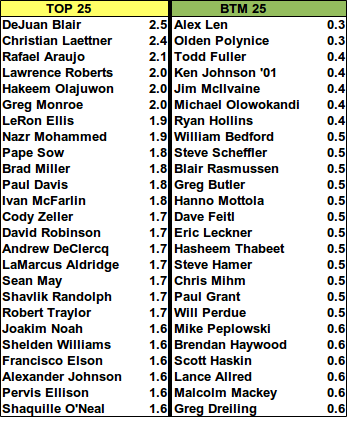Barncore wrote:It's impossible for metrics to catch the Beasleys and the Westbrooks of the world, simply because it can't take into account psychological intangibles. It can make pretty good guesses about a player's physical impact, his skill level, and his feel for the game. But it's the psychological intangibles that make the difference......
Here's some players with reported "poor psychological intangibles" (therefore may struggle to their potential, or they never did): Michael Beasley, Demarcus Cousins, Terrence Williams, pre-2012 JR Smith, Marreese Speights, Tyrus Thomas, Rashad McCants, Delonte West, Sean Williams, Julius Hodge, many more.
Definitely a correlation. Their growth curve largely depends on how they're wired internally. But there's no way to incorporate that into a metric without using subjectivity and guessing, since it's hard to get a feel for how a player is "wired" without meeting them in person. Even then it's hard to tell. All we have are draft interviews and general hearsay. If there was a way to measure this somehow THEN we would never miss a sleeper again.
It's a tricky thing. I was one that posted what seemed hundreds of times before the 2007 draft that Kevin Durant should have been the #1 pick over Oden - because of my ratings, but also my worries about Oden's health for the future (broke a bone in his hand at a young age, I figured broken foot bones in those massive feet would come - but alas it was knee. Plus, he already walked like an old man as a teenager). People argued Durant's lack of strength (not able to do one rep at 185 lbs on bench) was a sign of poor work ethic. I didn't agree, I just figured the kid was a serious gym rat (just played basketball) and never lifted - I saw that as "upside".
BUT, the very NEXT year - I posted many times that Beasley should have been #1 (and maybe Love #2) over Rose. Beasley was even more (slightly) "productive" statistically than Durant the year before, although some of Durant's outliers looked slightly better (steal & turnover rate specifically). I was pretty certain he and Love would be starters for many seasons and possibly/probably? multiple All Stars if they put the work in and avoid catastrophic injuries. Rose I doubted, in terms of future "stardom". Statistically, he looked fairly pedestrian, although my ratings rated him MUCH higher than one would expect for a PG who didn't break 15 pts, 5 ast, or 1.5 steals per game in college. I THOUGHT he had similar red flags to Beasley - mainly because it was common knowledge he cheated on the SAT to qualify (someone else took his test). BUT, statistically, he was a true freshman PG who rated well, which rarely happens except for future NBA starters/stars - which I better understand now. I just fell in love with the crazy positives the numbers showed for Beasley and Love. Oh, yeah, and Harden too. I can't wait to re-crunch the 2008 numbers, since my ratings have been tweaked some.
Anyway, I (and it appears others here) have a much better understanding of what the numbers mean than I did 5 years ago - but it hasn't changed THAT much. MANY NBA gms often are still notoriously bad about almost completely ignoring quality college production for combine scores, a few NBA camp looks, and team workouts.
The very first thing I will do when I finish the historical NCAA ratings is probably redraft the last 15 seasons based solely on just my basic impact rating (in relation to class) compared to the actual NBA drafts. I will include EVERY college player - so if a guy rated high enough to be drafted by my numbers but wasn't drafted in real life and never played a minute of NBA ball - I'll still include him in my results with a big fat zero for NBA production. I'm guessing my redrafted results on my most basic college rating will still be an improvement over real life. Of course, we'll be able to improve that even more when get into player statistical fingerprints and similarity scores - since a database or over 45,000 players who played quality minutes is no longer too small a sample size to work with.
But trolling over all these lines of data is SO tedious and slow. I can't wait until the groundwork is done - I wish I didn't have a "real" job.

BTW - great work other college to pro guys I've seen here - maybe by next season (when I'm caught up and others have best "tweaked" theirs) we'll be able to have a great thread on all our draft board comparisons based on our results.
Maybe I should keep my mouth shut until I can post real data - but you guys are inspiring me. Thanks!

